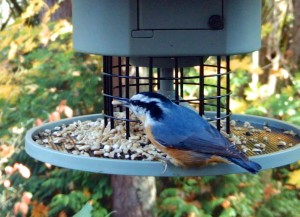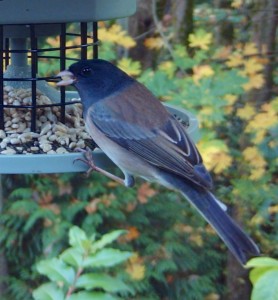When I first learned of the Wingscapes AutoFeeder, I’ll admit – I was a bit skeptical. After all, I’d fed birds in my back garden for years using traditional feeders and, aside from having to refill them a bit too often when the winter irruptions of Pine Siskins came through and cleaning the gunk out of the bottom of the seed chamber when the rains beat down heavy enough for water to get into them, they worked as well as I would have expected. So what possible benefits could a time-based dispensing feeder give me? As it turns out, quite a lot of them actually.
 First of all, the design of the Wingscapes AutoFeeder makes it a superb choice for rainy environments such as the Pacific Northwest. Not only is the main seed hopper completely impervious to wind-driven rain – and thus proof against its contents mouldering, it is impervious to squirrels as the lid cannot be removed when the metal arch from which it is hung is in hanging position. In addition to this, the feeder features a deep baffle that keeps the seed dry and prevents those previously mentioned squirrels from gaining access to the feeding platform from above.
First of all, the design of the Wingscapes AutoFeeder makes it a superb choice for rainy environments such as the Pacific Northwest. Not only is the main seed hopper completely impervious to wind-driven rain – and thus proof against its contents mouldering, it is impervious to squirrels as the lid cannot be removed when the metal arch from which it is hung is in hanging position. In addition to this, the feeder features a deep baffle that keeps the seed dry and prevents those previously mentioned squirrels from gaining access to the feeding platform from above.
And as to the timed dispensing of seed, as noted, a large feeding flock of birds can make short work of even a fully stocked feeder in little time at all – thus requiring it to be refilled more often. With the price of good quality seed being what it is, a feeder being emptied in a single afternoon isn’t particularly easy on the pocket book. However if, as the AutoFeeder allows, a controlled amount of seed can be made available to the visiting birds at specified intervals, not only will the seed last longer but top quality seed can be used without feeling that it is being wasted. Indeed, I have taken to using sunflower hearts (something I consider far too expensive to use in a conventional feeder) in my AutoFeeder; the birds love them, there is no shell mess to be cleared away, and every last kernel is eaten.
The principle is simple: the Wingscapes AutoFeeder can be programmed (very easily, I would point out) to dispense its contents at up to four specified times during a given twenty-four hour period. How much is dispensed during each release is controlled by how long the feeder is instructed to run its dispensing mechanism. I have found that a three or four second dispensing period three times each day provides enough seed to attract a good number of birds throughout the day with none left to sit on the platform overnight.
 While these benefits will certainly be welcome by anyone who feeds birds, the AutoFeeder can offer the additional benefit to classroom teachers of being programmed to dispense seed at the time most convenient for students to make any observations of the birds it attracts. Indeed, after only a few days in operation, the local birds seem to learn when the seed will be released. (I have personally witnessed my own back garden Dark-eyed Juncos gathering on nearby perches a few minutes prior to dispensing time each day.) For any teacher trying to make the most of a limited time period in their daily lessons for any nature observations, the AutoFeeder would be an exceptionally useful tool.
While these benefits will certainly be welcome by anyone who feeds birds, the AutoFeeder can offer the additional benefit to classroom teachers of being programmed to dispense seed at the time most convenient for students to make any observations of the birds it attracts. Indeed, after only a few days in operation, the local birds seem to learn when the seed will be released. (I have personally witnessed my own back garden Dark-eyed Juncos gathering on nearby perches a few minutes prior to dispensing time each day.) For any teacher trying to make the most of a limited time period in their daily lessons for any nature observations, the AutoFeeder would be an exceptionally useful tool.
Of all the feeders I have used over the years, few have impressed me more in their innovative design, ease-of-use, and efficiency than the Wingscapes AutoFeeder. It holds a generous amount of seed, it helps prevent seed spoilage and wastage, it resists squirrels, it is easy to clean (indeed, thanks to its feeding platforms well ventilated design it seems to resist becoming befouled in the first place) and it can greatly aid in he observation of the local birdlife by attracting activity at known times. I cannot think of another bird feeder I would more highly recommend for both home as well as school use.
